Abstract
Methods
A questionnaire regarding CL-related complications including patient’s gender, age, causative factors, and signs and symptoms was distributed to members of the Korean Ophthalmological Society by The Korean Contact Lens Study Society and the results of the questionnaire analyzed.
Results
Responses to the questionnaire written by ophthalmologists from 22 institutes and clinics were collected from 499 subjects over a 20-month period starting in October 2008 and analyzed. The mean age of respondents was 22.9 years and the male-to-female ratio was 1:8.1. The soft CL and cosmetic colored lens comprised the majority (46.6% and 42.1%, re-spectively) of the reported cases, followed by the rigid gas permeable lens (RGP lens; 10.6%) and orthokeratology lens (0.8%). In subjects using a cosmetic colored lens, 62.2% showed emmetropia and 89.1% of the lenses were prescribed by opticians. The main complications included corneal erosion, sterile corneal infiltrate, allergic disease, conjunctival injection, corneal ulcer, and dry eye syndrome. The most common causative factor of complications was excessive lens wear. Comparing main causative factors according to the RGP lens prescriber, the most common factor was poor lens fit.
Conclusions
The number of cosmetic colored lens-related complications in the emmetropic eyes of young patients is increasing rapidly. Considering opticians are the main CL prescribers in CL-related complications, Korean ophthalmologists need to pay more attention to CL fitting and constant education of patients regarding proper CL wear and care.
References
1. Choi TH, Kim HM, Cha HW. et al. The Korean Contact Lens Study Society. Research on the current status of contact lenses in Korea. J Korean Ophthalmol Soc. 2004; 45:1833–41.
2. The Korean contact lens study society. Contact lens complications. The Korean contact lens study society. Contact lens: princi-ples and practice. 1st ed.Seoul: Newaehaksul;2007. chap. 18.
3. Charles McMonnises, Russel Lowe. Lalitha CM Moodaley. After-care. medical aspect of contact lenses, diagnosis and treatment. Phillips Anthony J, Lynne Speedwell. LS, editors. Contact lenses. Elsevier;2007. chap. 17, 18.
4. Dong EY, Kim EC. The Korean lens study society. Results of pop-ulation - based questionnaire on the symptoms and lifes tyles associated with contact lens. J Korean Ophthalmol Soc. 2001; 42:30–5.
5. Lee DK, Choi SK, Song KY.Clinical survey of corneal complica-tions associated with contact lens wear. J Korean Ophthalmol Soc. 1994; 35:895–901.
6. Tchah HW, Kim JC, Hahn TW, Hahn YH.Epidemiology of contact lens related infectious keratitis (1995.4∼1997.9) : Multi-center Study. J Korean Ophthalmol Soc. 1998; 39:1417–26.
7. Lee WJ, Yoon GS, Shyn KH.Corneal complications in contact lens wearer. J Korean Ophthalmol Soc. 1996; 37:225–32.
8. Sauer A, Bourcier T. French Study Group for Contact Lenses Related Microbial Keratitis. Microbial keratitis as a foreseeable complication of cosmetic contact lenses: a prospective study. Acta Ophthalmol. 2011; 89:e439–42.
9. Steinemann TL, Pinninti U, Szczotka LB. . Ocular complica-tions associated with the use of cosmetic contact lenses from un-licensed vendors. Eye Contact Lens. 2003; 29:196–200.

10. Chalmers RL, Keay L, Long B. . Risk factors for contact lens complications in US clinical practices. Optom Vis Sci. 2010; 87:725–35.

11. Roberts A, Kaye AE, Kaye RA. . Informed consent and medi-cal devices: the case of the contact lens. Br J Ophthalmol. 2005; 89:782–3.

12. Chalmers RL, Wagner H, Mitchell GL. . Age and other risk factors for corneal infiltrative and inflammatory events in young soft contact lens wearers from the Contact Lens Assessment in Youth (CLAY) study. Invest Ophthalmol Vis Sci. 2011; 52:6690–6.

13. Cavanagh HD.Over the counter cosmetic colored contact lenses: déjà vu (disaster!) all over again! Eye Contact Lens. 2003; 29:195.

14. Steinemann TL, Fletcher M, Bonny AE. . Over-the-counter decorative contact lenses: Cosmetic or Medical Devices? A Case Series. Eye Contact Lens. 2005; 31:194–200.

15. Singh S, Satani D, Patel A, Vhankade R.Colored cosmetic contact lenses: an unsafe trend in the younger generation. Cornea. 2012; 31:777–9.
16. Ky W, Scherick K, Stenson S.Clinical survey of lens care in contact lens patients. CLAO J. 1998; 24:216–9.
17. Riley C, Young G, Chalmers R.Prevalence of ocular surface symp-toms, signs, and uncomfortable hours of wear in contact lens wear-ers: the effect of refitting with daily-wear silicone hydrogel lenses (senofilcon a). Eye Contact Lens. 2006; 32:281–6.

18. Hickson-Curran S, Chalmers RL, Riley C.Patient attitudes and behavior regarding hygiene and replacement of soft contact lenses and storage cases. Cont Lens Anterior Eye. 2011; 34:207–15.

19. Lee SY, Kim YH, Johnson D. . Contact lens complications in an urgent-care population: the University of California, Los Angeles, contact lens study. Eye Contact Lens. 2012; 38:49–52.

20. Michaud L, Giasson CJ.Overwear of contact lenses: increased severity of clinical signs as a function of protein adsorption. Optom Vis Sci. 2002; 79:184–92.

21. Teo L, Lim L, Tan DT. . A survey of contact lens complications in Singapore. Eye Contact Lens. 2011; 37:16–9.

22. Suchecki JK, Donshik P, Ehlers WH.Contact lens complications. Ophthalmol Clin North Am. 2003; 16:471–84.

23. Riley C, Chalmers RL.Survey of contact lens-wearing habits and attitudes toward methods of refractive correction: 2002 versus 2004. Optom Vis Sci. 2005; 82:555–61.

24. Suchecki JK, Ehlers WH, Donshik PC.Peripheral corneal in-filtrates associated with contact lens wear. CLAO J. 1996; 22:41–6.
25. Donshik PC, Suchecki JK, Ehlers WH.Peripheral corneal in-filtrates associated with contact lens wear. Trans Am Ophthalmol Soc. 1995; 93:49–64.
26. Robboy MW, Comstock TL, Kalsow CM.Contact lens-associated corneal infiltrates. Eye Contact Lens. 2003; 29:146–54.

27. Aquavella JV, DePaolis MD.Sterile infiltrates associated with contact lens wear. Int Ophthalmol Clin. 1991; 31:127–31.

28. Bourcier T, Thomas F, Borderie V. . Bacterial keratitis: predis-posing factors, clinical and microbiological review of 300 cases. Br J Ophthalmol. 2003; 87:834–8.

29. Sankaridurg PR, Sweeney DF, Holden BA. . Comparison of adverse events with daily disposable hydrogels and spectacle wear: results from a 12-month prospective clinical trial. Ophthalmology. 2003; 110:2327–34.
30. Solomon OD, Freeman MI, Boshnick EL. . A 3-year pro-spective study of the clinical performance of daily disposable contact lenses compared with frequent replacement and conventional daily wear contact lenses. CLAO J. 1996; 22:250–7.
31. Stapleton F, Dart JK, Minassian D.Risk factors with contact lens related suppurative keratitis. CLAO J. 1993; 19:204–10.
32. Radford CF, Minassian DC, Dart JK.Disposable contact lens use as a risk factor for microbial keratitis. Br J Ophthalmol. 1998; 82:1272–5.

33. Cheng KH, Leung SL, Hoekman HW. . Incidence of contact-lens-associated microbial keratitis and its related morbidity. Lancet. 1999; 354(9174):181–5.

34. Lam DS, Houang E, Fan DS. et al. Hong Kong Microbial Keratitis Study Group. Incidence and risk factors for microbial keratitis in Hong Kong: comparison with Europe and North America. Eye (Lond). 2002; 16:608–18.
35. Stapleton F, Keay L, Edwards K. . The incidence of contact lens-related microbial keratitis in Australia. Ophthalmology. 2008; 115:1655–62.

36. Dart JK, Stapleton F, Minassian D.Contact lenses and other risk factors in microbial keratitis. Lancet. 1991; 338(8768):650–3.

37. Poggio EC, Glynn RJ, Schein OD. . The incidence of ulcerative keratitis among users of daily-wear and extended-wear soft contact lenses. N Engl J Med. 1989; 321:779–83.

38. Dart JK, Radford CF, Minassian D. . Risk factors for microbial keratitis with contemporary contact lenses: a case-control study. Ophthalmology. 2008; 115:1647-54.e1-3.
Figure 1.
The distribution of lens type in reported subjects. SCL = soft contact lens; CCL = cosmetic colored lens; RGP = rigid gas permeable lens; OK = orthokeratology lens.
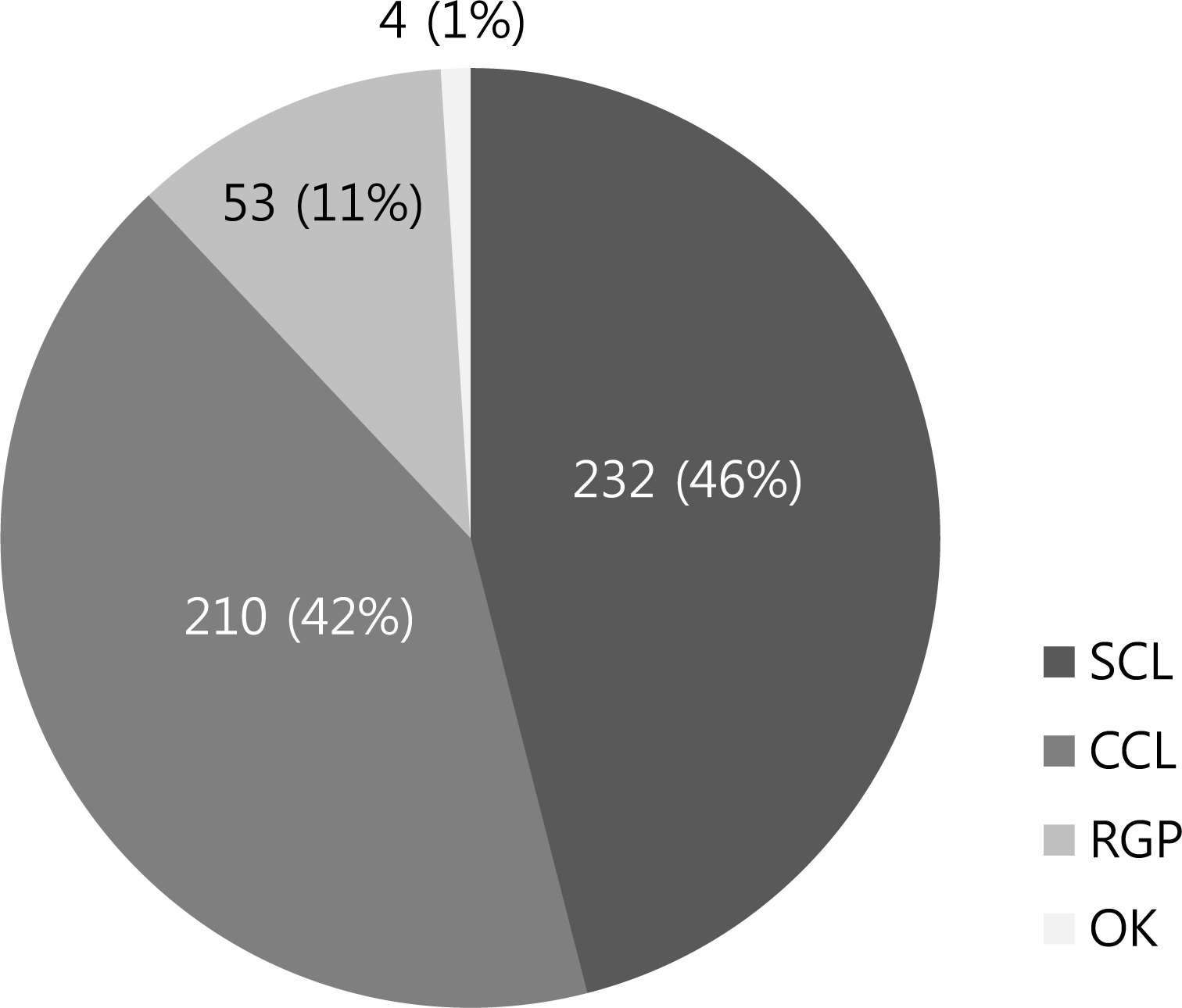
Figure 2.
The distribution of contact lens purchase route in total subjects (left) and respective lens type (right). SCL = soft contact lens; CCL = cosmetic colored lens; RGP = rigid gas permeable lens; OK = orthokeratology lens.
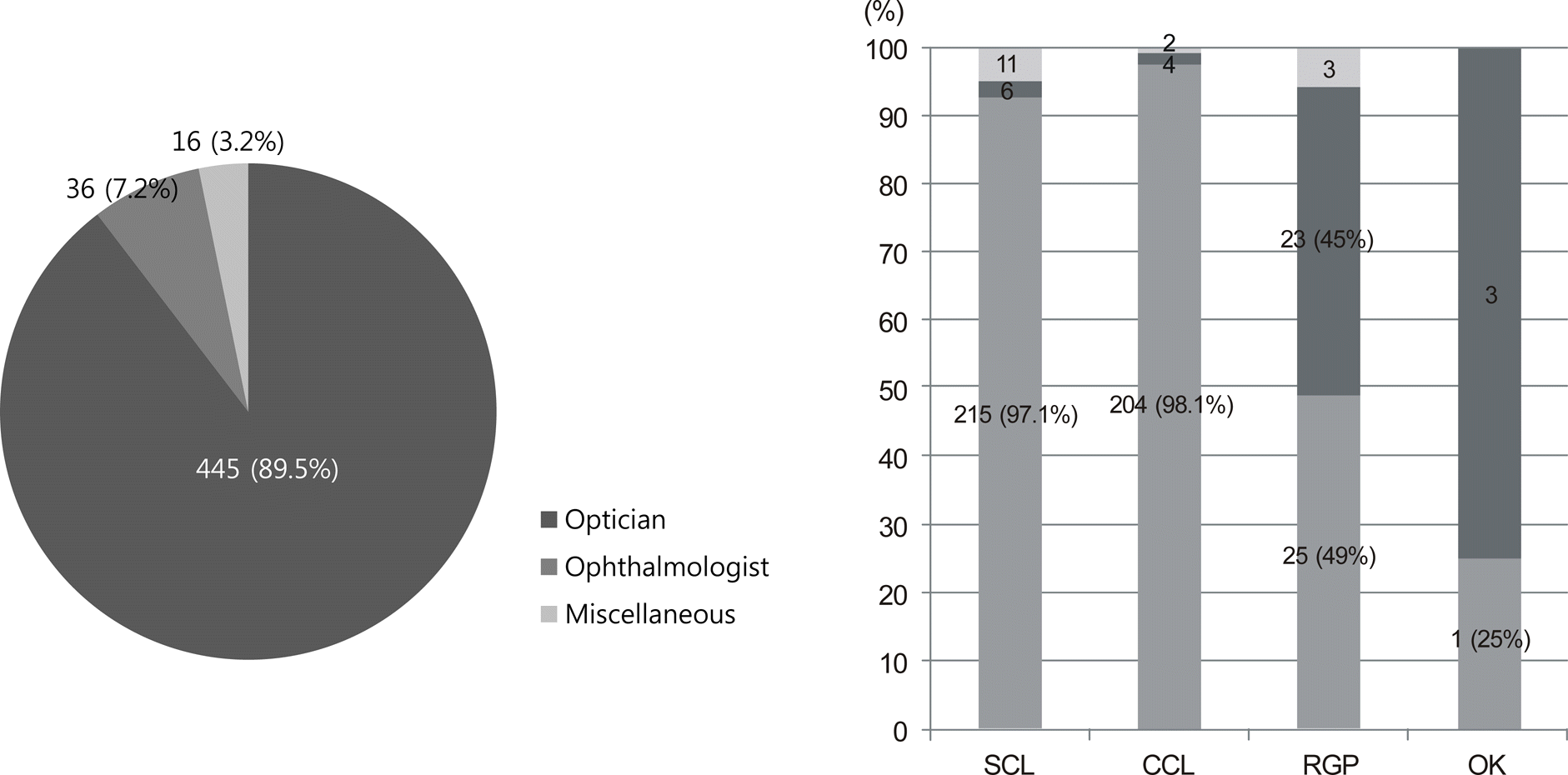
Figure 3.
The proportion of emmetropic subjects in cosmetic colored lens group according to age group. Vertical axis indicates age group & horizontal axis indicates the percentage of non-emmetropia and emmetropia. 10~19 = age from 10 to 19; 20~29 = age from 20 to 29; 30~ = older than 30 years old. * The proportion of emmetropic subjects was statistically significantly high in age group from 10 to 19 by Pearson chi square test (p = 0.021).
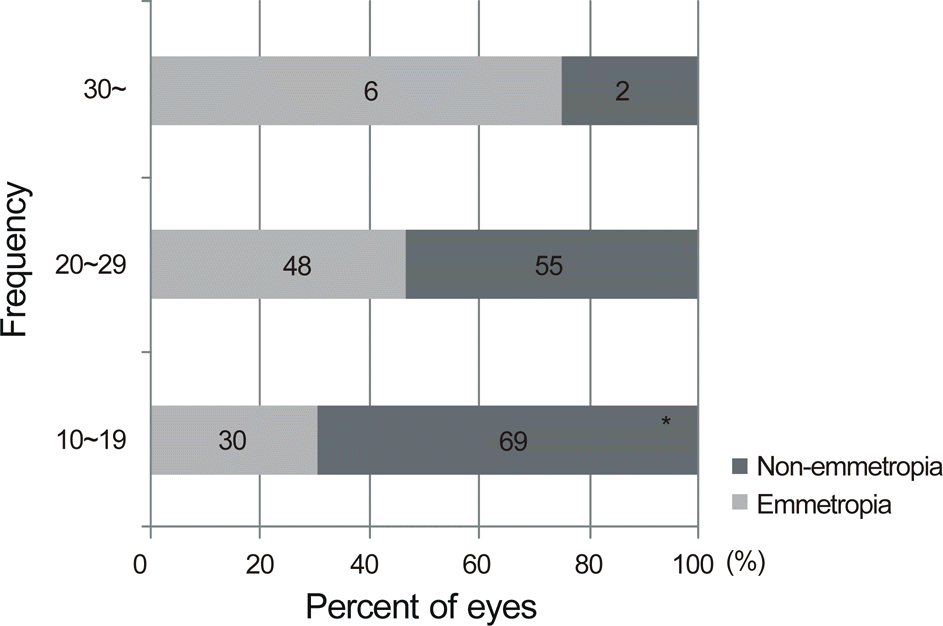
Figure 4.
The distributions of causative factors according to lens types by multiple response analysis. SCL = soft contact lens; CCL = cosmetic colored lens; RGP = rigid gas permeable lens.
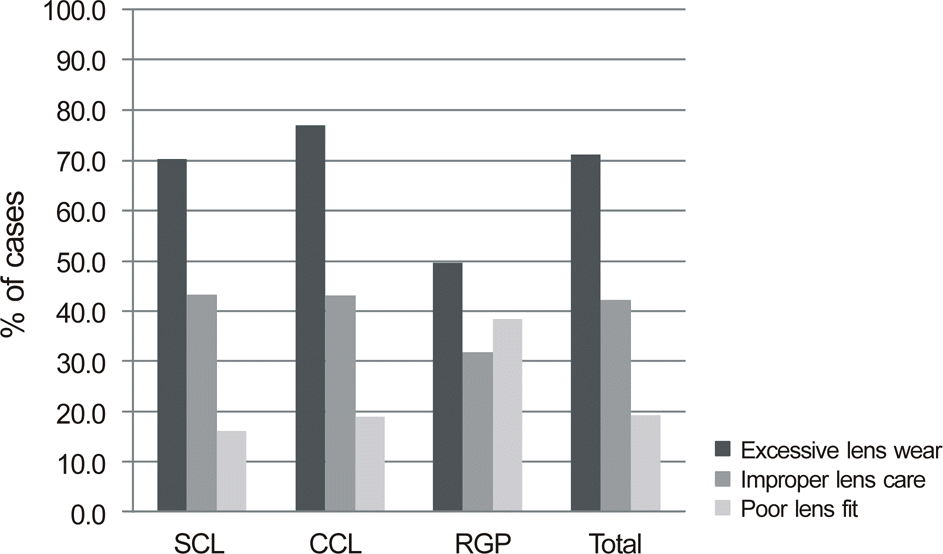
Figure 5.
Comparison of causative factors according to prescribers by multiple response analysis in RGP groups. * Statistically significant difference was shown between group prescribed by opticians and ophthalmologist (p = 0.004, Fisher’s exact test).
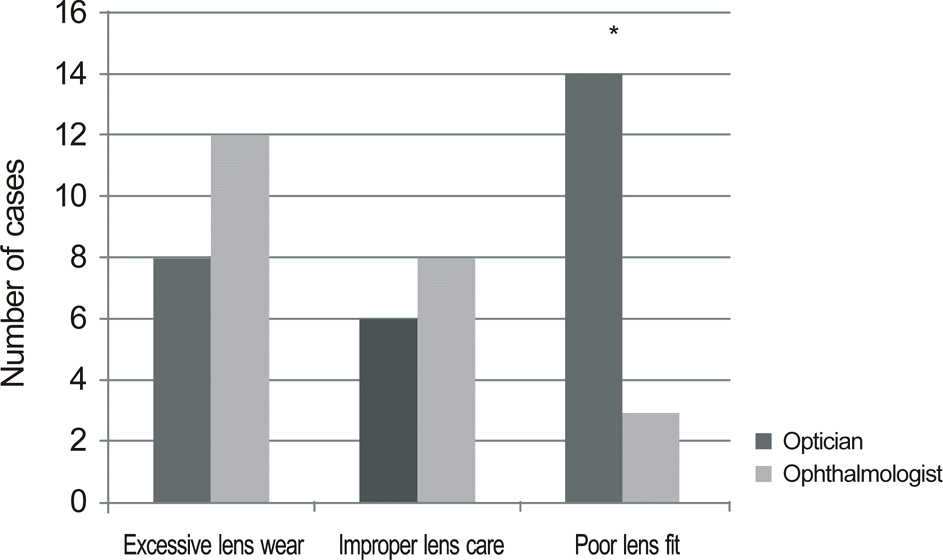
Table 2.
Regional distribution of reported subjects
| Region | Number of cases | % |
|---|---|---|
| Seoul | 194 | 38.9 |
| Gyeongsang province | 147 | 29.5 |
| Jeolla province | 116 | 23.3 |
| Gyeonggi province | 26 | 5.2 |
| Chungcheong province | 9 | 1.8 |
| Gangwon province | 7 | 1.4 |
| Total | 499 | 100 |
Table 3.
Occupational distribution of reported subjects
Table 4.
The comparison of patient’s age according to the lens type
| Mean | SD | Range | |
|---|---|---|---|
| SCL | 24.9 | 7.4 | 13-51 |
| CCL* | 20.6 | 4.9 | 12-40 |
| RGP | 23.9 | 8.0 | 11-55 |
| Total | 22.9 | 6.8 | 11-55 |
Table 5.
Distribution of subjects according to lens type and age group
| Age | SCL (%) | CCL (%) | RGP (%) | Total (%) |
|---|---|---|---|---|
| 10-19 | 45 (19.4) | 99 (47.2)* | 17 (32.1) | 161 (32.5) |
| (28.0) | (61.5) | (10.6) | (100) | |
| 20-29 | 143 (61.6) | 103 (49.0) | 26 (49.0) | 272 (54.9) |
| (52.6) | (37.9) | (9.6) | (100) | |
| ≥30 | 44 (19.0) | 8 (3.8)† | 10 (18.9) | 62 (12.6) |
| (71.0) | (12.9) | (16.1) | (100) | |
| Total | 232 (100) | 210 (100) | 53 (100) | 495 (100) |
| (46.9) | (42.4) | (10.7) | (100) |
Table 6.
Comparision of factors associated with lens wear and care among groups with different lens types
| Total subjects | SCL | CCL | RGP | p-value | |
|---|---|---|---|---|---|
| Daily wear time (hours) | 10.2 ± 3.0 | 9.8 ± 2.5 | 9.6 ± 3.0 | 10.4 ± 2.6 | 0.124 |
| (4-20) | (3-24) | (1-20) | (5-15) | ||
| Overnight wearing days (days/month) | 8.4 ± 7.6 | 9.7 ± 7.8 | 5.3 ± 2.8 | 16 ± 13.9 | 0.002* |
| (0-28) | (0-28) | (0-12) | (0-28) | ||
| Reused period after purchase (months) | 4.6 ± 5.2 | 4.5 ± 5.1 | 3.9 ± 4.1 | 8.2 ± 8.2 | <0.001† |
| (1 day-60) | (1 day-60) | (1 day-36) | (1 day-40) |
Table 7.
The Distribution of complications in contact lens related patients
| Complications | SCL | CCL | RGP | OK | Total | % |
|---|---|---|---|---|---|---|
| Corneal erosion | 54 | 45 | 31 | 1 | 131 | 26.3 |
| Sterile infiltration | 39 | 53 | 4 | 0 | 96 | 19.2 |
| Allergic disorder* (Giant papillary conjunctivitis) | 38 | 22 | 4 | 0 | 64 | 12.8 |
| (6) | (2) | (8) | (1.6) | |||
| Conjunctival injection | 29 | 28 | 3 | 2 | 62 | 12.4 |
| Infectious ulcer | 25 | 19 | 3 | 0 | 47 | 9.4 |
| Dry eye syndrome | 22 | 16 | 7 | 1 | 46 | 9.2 |
| Tight lens syndrome | 12 | 21 | 0 | 0 | 33 | 6.6 |
| Corneal neovascularization | 4 | 5 | 0 | 0 | 9 | 1.8 |
| Unclassified | 6 | 1 | 1 | 0 | 8 | 1.6 |
| Superior limbic keratitis | 2 | 0 | 0 | 0 | 2 | 0.4 |
| Conjunctival hemorrhage | 1 | 0 | 0 | 0 | 1 | 0.2 |
| Total | 232 | 210 | 53 | 4 | 499 | 100 |
Table 8.
Statistically significant factors related with complication type in each lens group
| Lens type | Complication type | Factor | p-value* | Odd ratio (95% CI) |
|---|---|---|---|---|
| SCL | Corneal ulcer | Age† | 0.04 | 1.076 (1.024-1.130) |
| Sterile infiltration | Age† | 0.002 | 0.887 (0.822-0.957) | |
| Female | 0.049 | 0.419 (0.176-0.997) | ||
| Allergic disorder | Female | 0.029 | 9.662 (1.254-74.434) | |
| Reused period after purchase‡ | 0.030 | 0.848 (0.730-0.984) | ||
| Tight lens syndrome | Daily wear time§ | 0.012 | 1.338 (1.065-1.681) | |
| CCL | Dry eye syndrome | Age† | 0.004 | 1.152 (1.047-1.268) |
| Reused period after purchase‡ | 0.035 | 1.102 (1.007-1.207) |




 PDF
PDF ePub
ePub Citation
Citation Print
Print


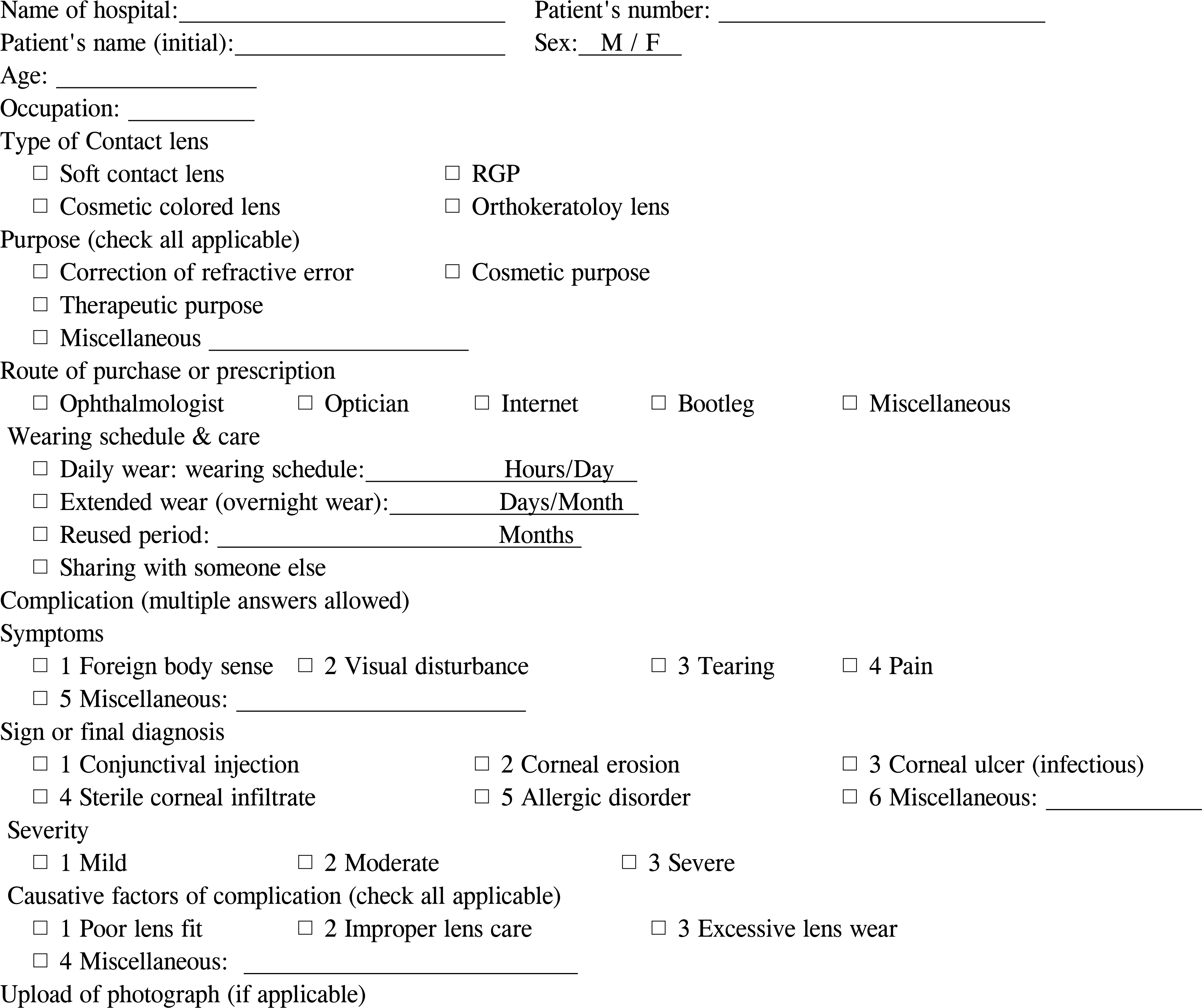
 XML Download
XML Download